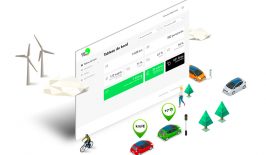Electric cars are to set shrink the automotive industry’s CO2 footprint by fossil-fuel powered engines and replacing them with more climate-friendly electric ones (with electricity from green, renewable sources of course). But what about the carbon footprint of the vehicles themselves? Replacing huge amounts of petrol-driven cars with environmentally-friendly electric ones means investing a huge amount of resources and energy in their construction. That also has a negative effect on the climate. And in addition to all that, the old cars will have to be scrapped or recycled – meaning huge amounts of energy used separating and processing the various materials.
Students at the TU/Ecomotive in Eindhoven, the Netherlands, have an idea for making the production and recycling cycle of electric cars much more sustainable: a car almost completely made of sustainable materials that is also completely recyclable.
Noah: A Car Made of Flax and Sugar
The two-seater named “Noah” is made of so-called polyactides (PLA) and flax. PLA is a synthetic polymer, also known as polylactic acid, which can be made from sugar and is already used in other industries for the production of biodegradable plastics. According to TU/Ecomotive, PLA and flax are not only regenerative and biodegradable. The production of the materials used to build the car also consumes up to six times less energy than conventional lightweight materials such as aluminium or carbon.
And Noah is really light too: without batteries it weighs only 360 kilos. Thanks to its low weight, the car manages to run on just a 60-kilo battery (other electric cars sometimes require batteries weighing several hundred kilos), which can transport it about 240 kilometres per charge.
What’s the makers’ motivation? “We want to show that circular economy is already possible in complex products such as cars,” says Cas Verstappen from the team of inventors at the TU/Ecomotive.
Noah definitely won’t be replacing the average family car just yet – it’s too small for that. But as soon as it is approved for use on public roads, it could be used in other ways, like for expanding cities’ car sharing fleets for example.
Want to know more about e-mobility? Then check out RESET’s E-Mobility Special!
This article is a translation by Marisa Pettit of an original article which first appeared on RESET’s German language site.






